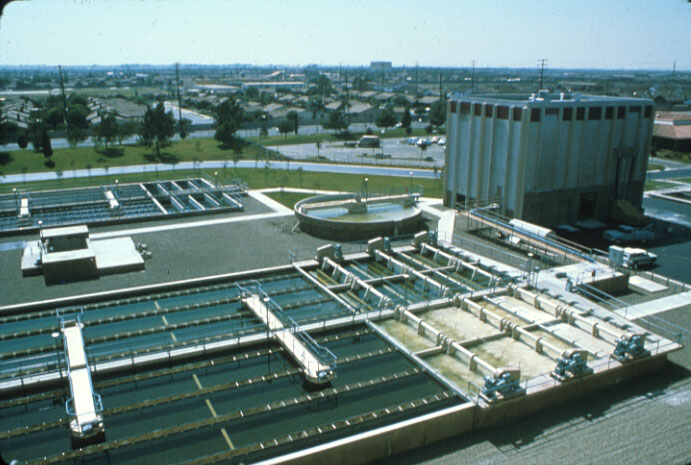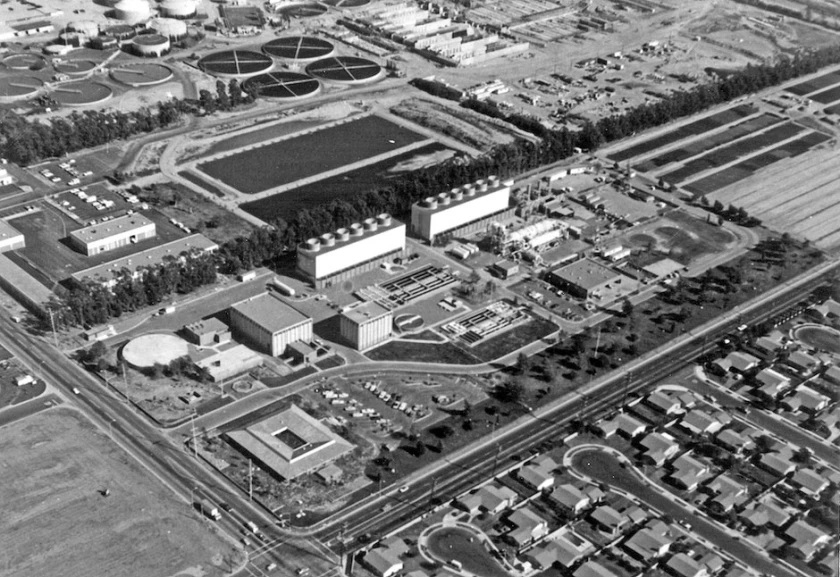
Water Factory 21 in the 1980s.
The landmark Groundwater Replenishment System (GWRS) began operation in January, 2008. Located in Fountain Valley the facility is operated by the Orange County Water District (OCWD) using secondary effluent produced by the Orange County Sanitation District (OCSD).
State-of-the-art technologies including microfiltration, reverse osmosis and ultraviolet disinfection are used to produce up to 70 million gallons per day (mgd) of recycled water. This water exceeds all federal drinking water standards. At the cutting edge of water recycling the GWRS is the subject of hundreds of requests each year for tours.
The size and complexity of the GWRS can awe the visitor. However, that visitor may be reminded that 35 years ago another trend setting facility was beginning operation at that very same site. This facility was demolished to make way for the GWRS. That original facility was called Water Factory 21.
People who received an education in water resources, water and wastewater treatment between 1975 to 2005 will always remember Water Factory 21 as the example of the application of advanced technology in the water industry.

Water Factory 21 opened in 1975 (OCWD).
The story of Water Factory 21 actually began in the 1950’s. Water demands rose rapidly with the growth of residential development as well as the construction of a renowned amusement park in Anaheim. The water table in Orange County was declining. Water spreading operations along the Santa Ana River helped. However, by 1956 it was noted that salt water intrusion had extended over three miles inland from the coast. The development of salt water barriers began in the mid-1960’s. OCWD worked with the Los Angeles County Flood Control District to create the Alamitos Barrier.
A larger barrier was planned by OCWD for the Talbert Gap. However, the development of the barrier would require a significant flow of imported water for injection. A 1963 Supreme Court decision to restrict the amount of Colorado River usage by the State of California foretold a future with less imported water supplies. OCWD’s search for an alternate injection water supply turned to recycled wastewater.
The use of recycled wastewater had actual been proposed as early as 1929. However, the technology of that era would not support the concept. Serious work by OCWD on wastewater recycling for injection began in the late 1963 with the construction of a pilot plant on the land adjacent to OCSD’s Plant No.1. The original pilot system included the following:
Treatment and injection with this pilot system began in 1965 and continued through 1970. The start-up and continued operation of the system was effectively a collaboration between OCWD and the State Board of Public Health.
The initial results of the pilot study were positive. It was proven that the recycled water could be injected. Viruses were not detected in either the injection well water or the observation well water. Coliforms were largely removed as the injected water flowed through the aquifer.
However, the level of color, odor, nutrient and organics in the observation well water indicated the need for further treatment. It was also noted that the treated water was too saline to allow effective dilution. Later testing would involve a blend of recycled wastewater and groundwater. Additional pilot treatment studies were conducted from 1970 to 1971.
The pilot treatment system included chemical clarification, ammonia stripping, recarbonation, mixed media filtration, carbon adsorption, and chlorination.
This study would form the basis of design for Water Factory 21. Eight years of study culminated in 1971 with State Board of Public Health approval of the construction of a 15 mgd wastewater treatment plant with the injection of the treated water into the underlying aquifer.
Bids were opened for the construction of Water Factory 21 in 1972. Construction of the facility lasted three years. Mack Wesner, Assistant District Engineer for OCWD at the time of the design, noted that the designers tried to use and improve on some of the concepts used at the South Tahoe Public Utility District tertiary water reclamation facility (as part of a design developed by Russell Culp).
The arrangement of processes at Water Factory 21 was as follows:
The plant had a focus on ‘sustainability’ over 30 years before the concept became vogue. Multi-hearth lime recalcining furnaces were used for recovery and reuse of the lime. Another furnace was included for the reactivation of granular activated carbon. Water Factory 21 began operation in April, 1975. The early years of operation were a learning experience.
Bill Dunivin, who would ultimately become the Operations Manager of Water Factory 21, noted the difficulties common to the operation of all lime facilities. However, he described the lime clarification process as the ‘work horse’ of the facility for its high treatment efficiency.
Mr. Wesner identified some of the innovations in the ammonia stripping towers design including media modules that could be easily removed for cleaning. The stripping towers would also provide cooling for the water produced in an adjacent ocean water distillation facility; the dispersing heat would in theory make the ammonia stripping more effective.
The injection of the recycled water from Water Factory 21 into the Talbert Gap salt water barrier began in October, 1976. A key part of the operation was blending. This part of the operation would change dramatically through the early operation of the facility.
The original concept for Water Factory 21 would take advantage of an ocean desalination project. Distallation was used in a joint project between OCWD and the Federal government (the Office of Saline Water). The facility was built at the Ellis Avenue location on the same site as the proposed Water Factory 21. The desalination facility was planned to have a capacity of 15 mgd.
The product water would be blended with the recycled wastewater to provide a less saline water supply for groundwater injection. The desalination facility also began operation in 1975. However, the 1973 oil embargo had a significant impact on energy intensive projects like desalination. The Federal government would stop funding for the desalination project after only one year of operation. One concept for continued operation of Water Factory 21 involved blending with deep well water.
There were concerns that the long term supply of deep well water was not sufficient to provide all the blending needs. OCWD turned to a process with minimal experience in the wastewater treatment field: reverse osmosis. The District constructed a 5 mgd reverse osmosis system in 1977 to demineralize a portion of the recycled wastewater flow. The remaining flow would receive additional treatment only through activated carbon adsorption.
The two recycled water flows were then combined and blended with sufficient deep well water to maintain the total dissolved solids concentration below 500 mg/L.
Dave Argo began work for OCWD prior to the start-up of the Water Factory 21. Mr. Argo would ultimately become District Engineer for OCWD. He recollected the challenges of working with the reverse osmosis membrane suppliers to procure membranes which would meet a performance specification.
The ongoing work with the suppliers would result in membranes that were more resistant to fouling and less energy intensive.
The operation of Water Factory 21 continued into the 1980’s and 1990’s. Continued monitoring resulted in the achievement of an important goal in 1991 when the Regional Water Quality Control Board issued a new permit which allowed OCWD to injected recycled water without prior blending.
In 1992 a plan to expand Water Factory 21 introduced microfiltration as a potential alternative to lime clarification. The concept for the GWRS evolved during the 1990s. The proposed facility involved a dramatic increase in scope.
The first phase of the project would produce 35 mgd for injection to maintain the salt water barrier while another 35 mgd would be conveyed to OCWD’s recharge basins in Anaheim. A long pilot process ensued to evaluate the microfiltration/reverse osmosis treatment process. A joint agreement was formed between OCWD and OCSD to pursue the project.
The GWRS required removal of the existing Water Factory 21. In January 2004, the shut down of Water Factory 21 began to make room for an interim system during the construction of the GWRS. The final demolition of Water Factory 21 began in January, 2007. One innovative facility came to an end to make way for a new generation of treatment technology.
Water Factory 21 as described in the prior paragraphs is about water, treatment processes, concrete, chemicals and membranes. A little more investigation reveals that Water Factory 21 is a story of people.
The roster of names that would have some involvement with Water Factory 21 is impressive. Howard Crooke. Landgon ‘Don’ Owen. Jim Cofer. Mack Wesner. Neil Cline. Perry McCarty. Dave Argo. Bill Dunivin. Richard Sudak. These are just a few of the names on the roster. The list could long continue of individuals who contributed innovation, persistence and hard work to a facility that would change an industry.
Of note, the three individuals interviewed for this article were asked to name one person who made a great contribution to Water Factory 21. All three responded with the name Don Owen. Mr. Owen served as OCWD from 1963 through 1973 first as District Engineer and later as General Manager. He would later be an elected Director for OCWD.
This tale of Water Factory 21 ends with the name itself. It is commonly known that the ‘21’ part of the title was intended to express the idea that this was the treatment facility of the 21st Century. The lore of Water Factory 21 has the phrase ‘Water Factory’ originating during a presentation by Don Owen to the League of Women Voters.
One of the audience members asked Mr. Owen for a more detailed description of the water recycling plant. After a further exchange of questions and answers between Mr. Owen and the inquisitive audience member, the woman came up with a way to summarize the facility. “Oh. It’s a water factory.”
The information in this article is largely derived from the following sources:
The OCWD should serve as an example to other water and wastewater utilities for maintaining historical records. It is easier to know where you have been when you can see the foot prints.
We would like to acknowledge Gina DePinto, Orange County Water District, and Debra Burris, DDB Engineering, for their assistance with this article.
Article originally published in the 2011 CWEA Wastewater Professionals magazine.